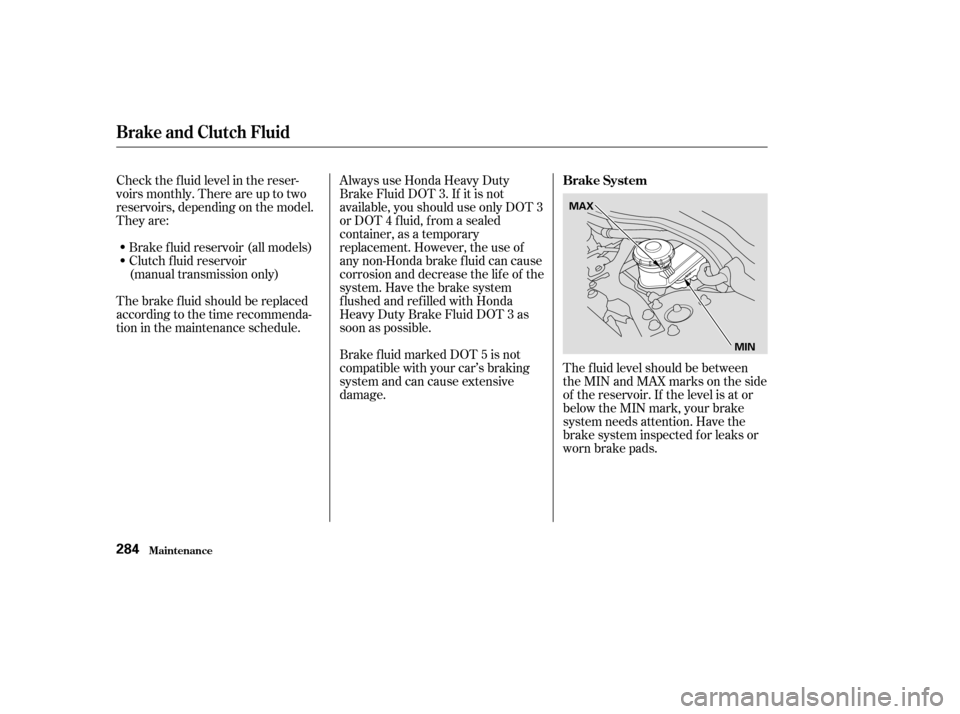Page 277 of 380

The f luid level should be between
theMINandMAXmarksontheside
of the reservoir. If the level is at or
below the MIN mark, your brake
system needs attention. Have the
brake system inspected f or leaks or
worn brake pads.
Always use Honda Heavy Duty
Brake Fluid DOT 3. If it is not
available, you should use only DOT 3
or DOT 4 f luid, f rom a sealed
container, as a temporary
replacement. However, the use of
any non-Honda brake fluid can cause
corrosion and decrease the lif e of the
system. Have the brake system
f lushed and ref illed with Honda
Heavy Duty Brake Fluid DOT 3 as
soon as possible.
Check the f luid level in the reser-
voirs monthly. There are up to two
reservoirs, depending on the model.
They are:
Brake f luid reservoir (all models)
Clutch f luid reservoir
(manual transmission only)
Brake f luid marked DOT 5 is not
compatible with your car’s braking
system and can cause extensive
damage.
The brake f luid should be replaced
according to the time recommenda-
tion in the maintenance schedule. Brake System
Brake and Clutch Fluid
Maint enance284
MAX
MIN
�����—�����—�����y���������������y���
�(�����������y���������y
Page 316 of 380

Block the rear wheels.
Fill the f uel tank.
Wash and dry the exterior
completely.
Cleantheinterior.Makesurethe
carpeting, floor mats, etc. are
completely dry.
Leave the parking brake off. Put
the transmission in Reverse
(5-speed manual) or Park
(automatic).
If you need to park your car f or an
extended period (more than one
month), there are several things you
should do to prepare it f or storage.
Proper preparation helps prevent
deterioration and makes it easier to
get your car back on the road. If
possible, store your car indoors.
If the car is to be stored for a
longer period, it should be
supported on jackstands so the
tires are of f the ground.
Leave one window open slightly (if
the car is being stored indoors).
Disconnect the battery.
Support the f ront wiper blade
arms with a f olded towel or rag so
they do not touch the windshield.
To minimize sticking, apply a
silicone spray lubricant to all door
and trunk seals. Also, apply a car
body wax to the painted surf aces
that mate with the door and trunk
seals.
Change the engine oil and f ilter
(see page ).
If you store your car f or 1 year or
longer, have your Honda dealer
perf orm the inspections as soon as
youtakeitoutof storage(seepages
, ). The 6-cylinder model
needs the inspections called f or in
the 2 years/30,000 miles (48,000 km)
maintenance schedule (Normal
Conditions) and the 4-cylinder model
needs the inspections called f or in
the 2 years/40,000 miles (64,000 km)
maintenance schedule (Normal
Conditions). The replacements
called f or in the maintenance
schedule are not needed unless the
car has actually reached that time or
mileage.
Coverthecarwitha‘‘breathable’’
cover, one made f rom a porous
material such as cotton. Nonporous materials, such as
plastic sheeting, trap moisture,
which can damage the paint.
If possible, run the engine f or a
while periodically (pref erably once
amonth).
270 250 255
St oring Your Car
Maint enance323
�����—�����—�����y��������
��
���y���
�(�����������y���������y
Page 326 of 380

If you have a f lat tire while driving,
stop in a saf e place to change it.
Stopping in traf f ic or on the shoulder
of a busy road is dangerous. Drive
slowly along the shoulder until you
gettoanexitoranareatostopthat
is far away from the traffic lanes.Open the trunk. Raise the trunk
f loor by lif ting up on the back edge.
Park the car on f irm, level and
non-slippery ground away f rom
traffic. Put the transmission in
Park (automatic) or Reverse
(manual). Apply the parking brake.
Turn on the hazard warning lights
and turn the ignition switch to
LOCK (0). Have all the
passengers get out of the car while
you change the tire. Take the tool kit out of the trunk.
Unscrew the wing bolt and take
the spare tire out of its well.
5. 4.
3.
2. 1.
CONT INUED
Changing a Flat T ire
T aking Care of t he Unexpect ed335
TRUNK FLOOR
SPARE TIRE JACK
TOOL KIT
The car can easily roll off the
jack, seriously injuring anyoneunderneath.
Follow the directions for
changing a tire exactly, and
never get under the car when it
is supported only by the jack.
�����—�����—�����y���������������y���
�(�����������y���������y
Page 331 of 380

Store the jack in its holder. Turn
the jack’s end bracket to lock it in
place. Replace the cover. Store the
tools.
Store the wheel cover or center
cap in the trunk. Make sure it does
not get scratched or damaged.Diagnosing why your engine won’t
start f alls into two areas, depending
on what you hear when you turn the
key to START (III):
You hear nothing, or almost
nothing. The engine’s starter
motor does not operate at all, or
operates very slowly.
You can hear the starter motor
operating normally, or the starter
motor sounds like it is spinning
f aster than normal, but the engine
does not start up and run. When you turn the ignition switch to
START (III), you do not hear the
normal noise of the engine trying to
start. You may hear a clicking sound
or series of clicks, or nothing at all.
Check these things:
Check the transmission interlock.
If you have a manual transmission,
the clutch pedal must be pushed
all the way to the f loor or the
starter will not operate. With an
automatic transmission, it must be
in Park or Neutral.
Turn the ignition switch to ON (II).
Turn on the headlights and check
their brightness. If the headlights
are very dim or don’t light at all,
the battery is discharged. See on page .
20. 21.
342
T aking Care of t he Unexpect ed
Changing a Flat Tire, If Your Engine Won’t Start
If Your Engine Won’t Start Nothing Happens or the StarterMotor Operates Very Slowly
Jump Starting
340
Loose items can fly around the
interior in a crash and could
seriously injure the occupants.
Store the wheel, jack, and tools
securely before driving.
�����—�����—�����y���������������y���
�(�����������y���������y
Page 333 of 380

Turn of f all the electrical acces-
sories: climate control, stereo
system, lights, etc.
Put the transmission in Neutral or
Park, and set the parking brake.
Open the hood and check the
physical condition of the battery
(see page ). In very cold
weather, check the condition of
the electrolyte. If it seems slushy
or like ice, do not try jump starting
until it thaws.
To jump start your car, f ollow these
directions closely:
If your car’s battery has run down,
you may be able to start the engine
by using a booster battery. Although
this seems like a simple procedure,
you should take several precautions.
You cannot start a Honda with an
automatic transmission by pushing
or pulling it.1. 2.294
T aking Care of t he Unexpect ed
Jump Starting
342
A battery can explode if you do
not follow the correct procedure,
seriously injuring anyonenearby.
Keep all sparks, open flames,
and smoking materials away
from the battery.
If a battery sits in extreme cold, the
electrolyte inside can f reeze.
Attempting to jump start with a f rozen
battery can cause it to rupture.
�����—�����—�����y���������������y���
�(�����������y���������y
Page 336 of 380

If you see steam and/or spray
coming f rom under the hood, turn
of f the engine.
If you do not see steam or spray,
leave the engine running and
watch the temperature gauge. If
the high heat is due to overloading
(climbing a long, steep hill on a
hot day with the A/C running, for
example), the engine should start
to cool down almost immediately.
If it does, wait until the tempera-
ture gauge comes down to the mid-
point then continue driving.
Saf ely pull to the side of the road.
Put the transmission in Neutral or
Park, and set the parking brake.
Turn of f the heating and cooling
system and all other accessories.
Turn on the hazard warning
indicators.
The pointer of your car’s tempera-
ture gauge should stay in the mid-
range under most conditions. It may
go higher if you are driving up a long
steep hill on a very hot day. If it
climbs to the red mark, you should
determine the reason.
Your car can overheat f or several
reasons, such as lack of coolant or a
mechanical problem. The only
indication may be the temperature
gauge climbing to or above the red
mark. Or you may see steam or
spray coming f rom under the hood.
In either case, you should take
immediate action. 1.
2. 3.
CONT INUED
If Your Engine Overheats
T aking Care of t he Unexpect ed345
Steam and spray from an
overheated engine can
seriously scald you.
Do not open the hood if steam
is coming out.
Driving with the temperature gauge
pointer at the red mark can cause
serious damage to your engine.
�����—�����—�����y���������������y���
�(�����������y���������y
Page 349 of 380

�µ�µ �µ
Automatic Transmission:
5-speed Manual Transmission:
There are three popular types of
prof essional towing equipment.
The operator
loads your car on the back of a truck.
The tow
truck uses two pivoting arms that go
under the tires (f ront or rear) and lif t
them of f the ground. The other two
tires remain on the ground. The tow
truck uses metal cables with hooks
on the ends. These hooks go around
parts of the f rame or suspension and
the cables lif t that end of the car of f
the ground. Your car’s suspension
and body can be seriously damaged.
If your Honda cannot be transported
by f lat-bed, it should be towed by
wheel-lif t equipment with the f ront
wheels of f the ground. If due to
damage, your car must be towed
with the f ront wheels on the ground,
do the f ollowing:
Release the parking brake.
Shif t the transmission to Neutral. With the f ront wheels on the ground,
it is best to tow the car no farther
than 50 miles (80 km), and keep the
speedbelow35mph(55km/h).
If your car needs to be towed, call a
prof essional towing service or, if you
belong to one, an organization that
provides roadside assistance. Never
tow your car behind another vehicle
with just a rope or chain. It is very
dangerous.
Release the parking brake.
Start the engine.
ShifttoD,thentoN.
Turn of f the engine.
Flat -bed EquipmentWheel-lif t Equipment Sling-t ype Equipment
This is the best way to transport
your Honda.
T his is
an acceptable way to tow your
Honda. T his method of towing is
unacceptable.
Emergency T owing
T aking Care of t he Unexpect ed358
Improper towing preparation will
damage the transmission. Follow the
above procedure exactly. If you cannot
shif t the transmission or start the
engine (automatic transmission), your
car must be transported with the f ront
wheels of f the ground.
�����—�����—�����y�������������
�y���
�(�����������y�������
�y
Page 353 of 380
The Transmission Number is on a
label on top of the transmission.
The Engine Number is stamped into
the engine block. It is on the f ront.
Identif ication Numbers
T echnical Inf ormation
4-cylinder Models 6-cylinder Models
363
AUTOMATIC TRANSMISSION NUMBER
ENGINE NUMBER
AUTOMATIC TRANSMISSION NUMBER
MANUAL
TRANSMISSION
NUMBER
ENGINE
NUMBER
�����—�����—�����y���������������y���
�(�����������y���������y